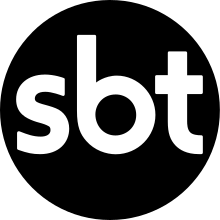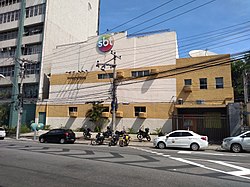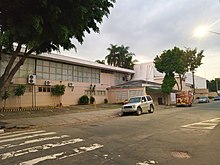

This article has multiple issues. Please help improve it or discuss these issues on the talk page. (Learn how and when to remove these template messages)
|

Logo used since 2014.
| |
| Type | Free-to-air television network |
|---|---|
| Country | Brazil |
| Stations |
|
| Affiliates | See List of SBT affiliates |
| Headquarters | CDT da Anhanguera, Osasco, Brazil |
| Programming | |
| Language(s) | Portuguese |
| Picture format | 1080i HDTV (downgraded to 480i for the SD feed) |
| Ownership | |
| Parent | Grupo Silvio Santos |
| History | |
| Founded | 19 August 1981; 42 years ago (1981-08-19) |
| Founder | Silvio Santos |
| Replaced | Rede Tupi Rede Excelsior |
| Links | |
| Website | www |
| Availability | |
| Terrestrial | |
| Digital terrestrial television | 24 UHF (Brasília, Rio de Janeiro, Jaú, Ribeirão Preto & Nova Fribugo) 26 UHF (Belém) 28 UHF (São Paulo and Porto Alegre) |

The Sistema Brasileiro de Televisão (Brazilian Portuguese: [sisˈtemɐ bɾaziˈlejɾu dʒi televiˈzɐ̃w]; SBT [ˈɛsi ˈbe ˈte]; "Brazilian Television System") is a Brazilian television network founded on Wednesday, 19 August 1981, by the businessman and television personality Silvio Santos.[1][2] The company was established after a public tender by the Brazilian Federal Government to form two new networks, created from revoked concessions of the defunct Tupi and Excelsior networks.[3] The SBT was founded on the same day that the concession agreement was signed, and that the act was broadcast live by the network, so that this was his first program aired.[4][5] Before acquiring the concessions of the four station that were to form the SBT, Grupo Silvio Santos had since 1976 the concession of Rio de Janeiro's channel 11, known as TVS Rio de Janeiro (now SBT Rio), which was a fundamental step to give life to the SBT.[6][7]
In April 2018, the SBT was the second-most watched television network in Brazil, behind Globo.[8] Throughout its existence, the network always occupied the space in the audience ranking, except between 2007 and 2014, when the Record network took its place.[9][10][11][12][13][14] In May 2024, the SBT was the thirteen-most watched television network in Brazil, behind TV Aparecida. The SBT has a total of 114 broadcast television stations (O&Os and affiliates) throughout the Brazilian territory,[2][15][16] and is also available through pay television operators (cable and satellite), free-to-air signal on satellite receivers and also through streaming media in their mobile application (Android, iOS and Windows), applications for smart TVs and its website.[16][17][18][19] Also on their website, its programming is available in video on demand for free, also available from the video-sharing site YouTube since 2010.[20][21] In March 2017, the 43 channels of the SBT on YouTube accumulated 20 million subscribers and 70 billion minutes watched.[22]
The SBT broadcasts their programming a wide variety of television genres, whereas its own material generally stand adjacent to the entertainment.[17] Foreign programming, mainly the telenovelas produced by the networks owned by the Mexican conglomerate Televisa, are part of their program schedule.[23][24][25][26] It is the only commercial television broadcaster in Brazil which airs children's programming, even arranging a partnership with The Walt Disney Company, in which the company provides two hours of daily programming for the network.[1][27][28][29][30][31] The network also possess times for the television news, producing in all three daily newscasts, a weekly news program and a weekly newscast.[32][33][34]
The network owns the CDT da Anhanguera, a television complex located at the kilometer 18 of the Rodovia Anhanguera, in Osasco, São Paulo, occupying an area of 231 thousand square meters.[35] This is the third largest television complex in size installed in Latin America, being smaller only that the studios of TV Azteca, in Mexico, and the Estúdios Globo.[36]
Rede Tupi, the channel 4 in São Paulo, began operations in 1950. In 1962 (when he began his first TV program), Silvio Santos produced his own programs on Tupi, TV Paulista and on Rede Globo beginning in 1965. Soon enough, he started plans to have his own television channel. His production company, Estudios Silvio Santos Cinema e Televisao, was successful on Tupi, Globo and (since 1972) on Record (where he then owned half of the company's stock).
In 1976, with help from humorist and friend Manuel de Nóbrega (who had a show on Rede Globo and was part of Baú da Felicidade), Santos obtained a license for his own station: Rio de Janeiro's channel 11, known as "TV Studios" or "TVS". Soon after its launch, its flagship program (Programa Silvio Santos on Sundays) plus the late night Silvio Santos Diferente on weekdays began to be broadcast (Santos left Globo the same year). Other programs soon began, as the network gained support from city residents who sought an alternative to Globo, Tupi, Bandeirantes and TV Rio (the city's network, related to TV Record along with TVS). The new channel debuted on 14 May 1976, with a logo of a gold circle with the number 11 slanted in gold, which featured in the first Scanimate idents and promos for the channel - making it a pioneer station in the country when it came to computer animation. While during its early years the network studios were based in Rio, all program production for TVS transferred to São Paulo in 1978–79.

When Rede Tupi went out of business in 1980, Santos obtained three stations from the network: the São Paulo's channel 4, the Porto Alegre's channel 5 and the Belém's channel 5. The SBT was created, launching on 19 August 1981, but using the TVS name until 1990 for some of its stations. Until the formation of the SBT, the Silvio Santos Group also had a station named TVS in Nova Friburgo, serving viewers in the northern and western parts of the state, this was also its first branch station, having opened in 1979.
In 1978, Minas Gerais' TV Alterosa became one of the SBT's broadcast-affiliate networks, the first affiliate station for the channel. Some later affiliates were adopted from Rede Tupi after its closure on 18 July 1980, by order of Brazilian Minister of Communications Haroldo de Matos, who the following year would order SBT to begin transmissions. When Tupi closed, Programa Silvio Santos moved to Record but continued simulcasting Sundays on the TVS Channels 11 and 3, as well as on yet another SS Group station - Channel 9, purchased from TV Continental. Santos began the network's expansion efforts, convincing stations to become the SBT and Record affiliates. The official launch of the network on 19 August 1981, also marked the debut of its first presentation package using its famous circle logo (similar to the one used till today by the American Broadcasting Company) and dual branding (the SBT being the official name of the network while TVS being the station branding in its three founding stations), and it was the only network launch to be held in Brasilia and broadcast directly from the federal capital city. The first idents were similar to ABC's Still the One idents of 1979, used by the Nine Network in Australia in 1980.
The Matos decision also gave the network the Sumare studios of Tupi for drama production. By the time of the 1981 launch the SBT had 18 affiliate channels nationwide.

During the 1980s, the SBT established itself, contracting popular hosts and airing a mix of its own and Televisa programming (especially Mexican telenovelas and comedy shows such as El Chavo del Ocho and El Chapulín Colorado). It climbed to second place in the Brazilian ratings (except in Rio de Janeiro, where Rede Manchete occupied that position). Moreover, it hosted the Brazilian version of Bozo for kids plus even let ex-Tupi program presenters bring their shows over to the fledgling network.
The SBT, together with Record (under the SBT/Record pool) broadcast the 1984 Summer Olympics in Los Angeles, two years before its 1986 FIFA World Cup coverage.
1985 would see the SBT score a historic victory with the broadcast of the Australian miniseries The Thorn Birds, and TVS Channel 4 São Paulo became SBT Channel 4 São Paulo, thus becoming a truly national network with the introduction of satellite broadcasts.
In March 1986, the network premiered its new talk show, Hebe, with Hebe Camargo as host; the show was formerly on Rede Tupi and Rede Bandeirantes. It became one of the network's longest-running programs, running for over 24 years; the final show was at the end of 2010, when Camargo ended her contract. She had a spin-off show, Hebe por Elas (Hebe for All), during the early 1990s. The death of Flavio Cavacante, one of the network's pioneer presenters, just days after his 22 May episode of his own program shocked the nation so much that on the day of his funeral the network started transmissions only in the afternoon in his honor.
In 1987, Santos pursued a better-quality program lineup, while trying to attract a larger audience and better advertisers. During that year (in response to the high popularity of Rede Globo's Xou da Xuxa on weekdays), SBT began increasing its child-oriented programming with programs such as Oradukapeta, Show Maravilha and the Do Re Mi series. Nearly all SBT kids' programs had female presenters (different from the format of Xou da Xuxa), because Oradukapeta was hosted by Sergio Mallandro (also a Show de Calorous judge).
The network also launched its slogan "Quem procura, acha aqui", modeled on NBC's three-year "Be There" campaign project from 1983 to 1985. The slogan lasted for three seasons, with a new promo each year. The theme used each year corresponded to NBC's theme for its project:
Even all program adverts were also modeled on the NBC ones, with the 1989-90 edition seeing the program talents saying the day the program will be aired followed by the phrase No SBT (On SBT) with the program time being shown, this style was carried on to 1990.
1987 also was the year that the network began to change its corporate branding from TVS to the SBT, and the 2nd year of its "QPAA" campaign resulted in the logo being relaunched, now with slanted colors on the circle (similar to ABC's 1987-88 logo and its "Something's Happening on ABC" campaign).
Humorist Jô Soares was brought in from TV Globo in 1988, introducing a late-night talk program to Brazilian TV with his 11:30 PM show entitled Jô Soares Onze e Meia. Also signed was Boris Casoy, who became the first news anchor in Brazil with his TJ Brasil newscast (which succeeded Noticentro, the network's first newscast with Antonio Casale) and ex-Balão Mágico member Simony.
In 1988, Santos prevented host "Gugu" Liberato from signing with Globo after Liberato hosted the SBT's big weekend hit Viva a Noite since 1986. This was widely seen as indicative that Gugu would be Santos' successor on Sunday afternoons, reinforced by the extended timeslot of Gugu's future program Domingo Legal. As a result, Programa Sílvio Santos adopted the dual-presenter format, with Gugu hosting segments such as the Brazilian version of Double Dare, called Passa ou Repassa (known for its "Torta na Cara" segment) and Cidade contra Cidade.
The TVS brand was merged into the SBT brand in 1990; the name change was seen in a new campaign ad modeled on NBC's "Come Home to NBC" campaign of 1986–87, which premiered early that year, and in August on TV station identifications celebrating SBT's ninth year of broadcasts (that year, Silvio Santos sold Record as a national network) and it also broadcast the 1990 FIFA World Cup. 1991 saw the beginning of its newscast Aqui Agora and Serginho Groisman's Programa Livre variety show, just a few of the many successes for the year even as the network's São Paulo studios suffered damages due to massive floods that hit the city. In 1992, the SBT and Rede Globo (together with Manchete, Band, and SporTV) jointly broadcast the 1992 Summer Olympics and the 1996 Summer Olympics (together with Manchete, Record, Band, SporTV, and ESPN) nationwide, with a grand advertising campaign for the Brazil national team. Despite problems and even the transfer of talents to other stations (such as the then resurgent Rede Record), the 90s proved to be a boom for the network, beginning its second decade with 74 affiliates, bigger when it signed on.
The SBT invested in its own telenovelas and remakes of successful ones from foreign networks (most notably Chiquititas), variety programs, news and current affairs, and broadcast rights for sporting events (including the Copa Mercosur, Copa do Brasil and Champ Car). It signed host Carlos "Ratinho" Massa in 1998, obtained more Mexican productions and launched game shows (such as Show do Milhão) in 1999. By the end of the decade the SBT held second place in the Brazilian ratings, after Globo, strengthed by a brand new and technologically advanced television complex, the CDT da Anhanguera, inaugurated in 1996, just in time for its 15th anniversary.
The 1990s were the SBT's most fruitful decade for American-style ad campaigns:
The SBT began the decade investing in movies, broadcasting a package of Disney (now affiliated with TV Globo) and Time Warner productions (the latter promoted in a one-hour network block). In 2001, the controversial reality show Casa dos Artistas, accused by many of being a copy of Endemol's Big Brother, marked the first time SBT led the Sunday-night ratings, aside from its Domingo Legal program becoming no.1 in the Sunday afternoon ratings.
Since 2003, with the ratings advances of Record and Rede Bandeirantes, the SBT's ratings have declined. Two events that year marked the beginning of its problems:
Since then the SBT has aired the successful Rebelde and shows with child host Maisa Silva, who became popular; however, programs could change without previous announcement (even hosts were sometimes out of the loop), confusing the audience. In 2006 SBT celebrated its 25th anniversary in a deepening crisis.
The SBT is the second-largest network in the country, vying for leadership with Rede Record. The CDT da Anhanguera is the second-largest television-production center in Brazil, behind Projac (owned by Rede Globo). Over 5,000 employees work around the clock at the SBT's 110 TV stations. In 2008 the network lost second place in the ratings to Record, but tied for second place the following year. In 2009 Liberato moved to Record after more than 20 years with the SBT; at the same time, the SBT signed presenters Roberto Justus and Eliana from Record. It also appeared on SKY Brasil, the last of the five major Brazilian networks to do so.
Recent programs include What's Your Talent, a local combination of Britain's Got Talent and Show de Calouros (created and hosted by Silvio Santos during the 1970s); a Brazilian version of 1 vs. 100; an annual telethon, which raised R$19 million in 2009; Kyle XY; the reality show Solitary; Smallville, Grey's Anatomy and De Frente with Gabi, a talk show featuring journalist Marilia Gabriela.
TV Alagoas left the network in September 2009 and to broadcast religious programs, and SBT executive director William Stoliar sued to ensure the network's availability there. It returned to the SBT on June 1, 2010, due to viewer pressure and late rent payments by religious programs.
In February 2014 the Communist Party of Brazil sends to the Federal Government a questioning, for which he cut around 75 million dollars in advertising the broadcaster, because of criticism that the journalist Rachel Sheherazade makes against the Government.[37]
While the network at large suffered from the effects of the COVID pandemic in the country, it found a renewed calling in sports. One after the other, the network pursued new sporting investments when it snagged the broadcasting rights for the Campeonato Carioca 2020 grand final, followed by a renewed commitment to the Copa Liberatores for the 2020–22 period. In 2021, left and right came contracts after contracts for sports broadcasts with SBT getting the nod as broadcaster to the 2021 Copa America, and a number of arena football and futsal events - a first in network history as SBT marked its 40th anniversary. Buoyed by the sporting successes against the competition the network revived its sports newscasts: Arena SBT, which originally premiered in 2014, returned in 2020, followed by the launch the following year of SBT Sports.




The SBT has most of its schedule dedicated to programming for children and pre-teens, and it is a popular network with young audiences. In 1998 it ran the longest children's programming block in Brazilian TV history with TV Cultura, from Sessão Desenho (a cartoon block) at 7:00 AM (after the morning newscast) until 9:00 PM (when the children's telenovela Chiquititas ended). The SBT promoted the 14-hour block as "SBT Kids".
While most TV stations in Brazil depend on domestic productions, the SBT relies on imports (mainly from Mexico and the US). Since 1984, El Chavo del Ocho (shown in Brazil as Chaves) is one of the station's most popular programs. The network had until 2014 an agreement with Warner Brothers, giving it an exclusivity deal for its sitcoms, dramas and films.
Mexican telenovelas have been a staple on the SBT, reaching their peak during the early 1990s with the child-oriented Carrusel, La usurpadora, El Privilegio de Amar and Luz Clarita and the popular『María trilogy』(María Mercedes, Marimar and María la del Barrio). Compared to subdued Brazilian telenovelas, Mexican soaps are considered tacky and exaggerated.
Other 1990s hits included Domingo Legal (Cool Sunday) (a Sunday variety show which was the SBT's highest-rated program, surpassing TV Globo), and the network was the most popular channel in Brazil for hours at a stretch. Domingo Legal was criticized for its sensationalism, and its ratings began to fall after the Primeiro Comando da Capital (PCC) scandal (see below); the show often ranks second in the ratings. Other popular programs included Programa do Ratinho (Ratinho's Show, with a similar format to The Jerry Springer Show), Show do Milhão (The Million Show, similar to Who Wants to Be a Millionaire?), Topa Tudo por Dinheiro (Variety show large audience that was aired on Sunday night between 1991 and 2001), Fantasia (Entertainment program where people could play games by phoning the program in order to earn money), and the Brazilian version of the Argentinean soap opera Chiquititas, popular with children.
For over 20 years the SBT held second place in the Brazilian television ratings (behind Rede Globo), but in February 2007 it was outpaced by Rede Record for the first time in São Paulo. However, after a period of resurgence which started in 2011, SBT successfully overtook Record for second place in June 2014.
Since their 1990s peak in popularity, Mexican telenovelas have been steadily declining in the ratings; the last popular Mexican soap operas were Carita de Ángel in the early 2000s and Rebelde in 2006. In 2001, SBT began remaking Mexican soaps with Brazilian actors. The first soaps (Picara Sonhadora and Marisol) did fairly well in the ratings; however, later soaps (Cristal, Os Ricos Também Choram and Maria Esperança, a version of the popular Maria Mercedes) were less popular.
In addition to Mexican soaps and their remakes, the channel also airs cartoons mornings and programs such as Ídolos (a Brazilian version of American Idol which later moved to TV Record), a Brazilian version of Supernanny, a version of Deal or No Deal (presented by Silvio Santos, who also presents many network programs), talent shows and a dating show. The network also airs movies and A Praça é Nossa (a long-running, popular comedy program).
(...) O SBT foi a primeira emissora aberta do Brasil a firmar uma parceria com o YouTube, em 2010 (...)
{{cite web}}: CS1 maint: multiple names: authors list (link)
{{cite web}}: CS1 maint: multiple names: authors list (link)
|
| |||||||||||||||
|---|---|---|---|---|---|---|---|---|---|---|---|---|---|---|---|
| |||||||||||||||
| |||||||||||||||
| International |
|
|---|---|
| National |
|